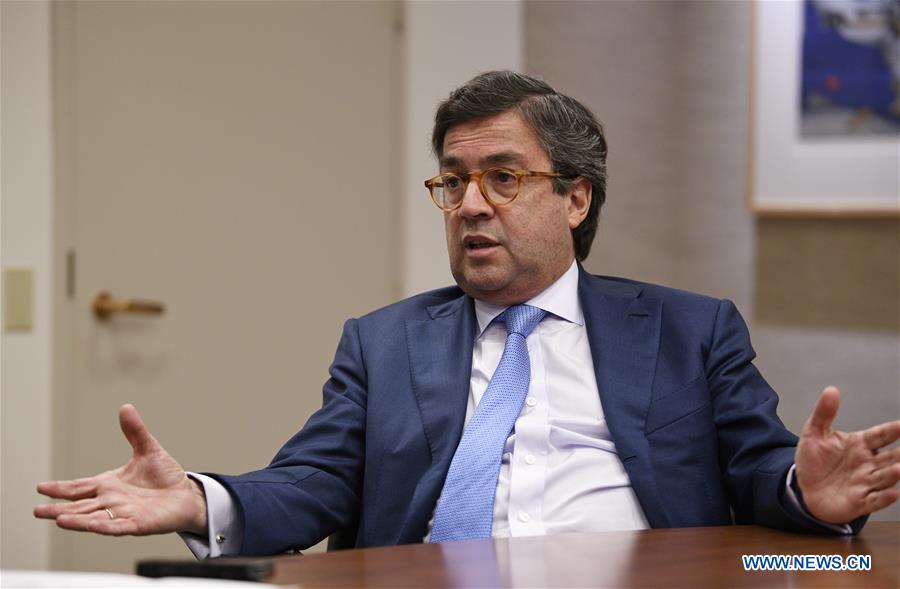
Luis Alberto Moreno, president of the Inter-American Development Bank (IDB), receives an interview with Xinhua at the headquarters of the IDB in Washington D.C., the United States, April 23, 2019. There is "a lot of space for cooperation" with China in the Latin American region under the framework of Belt and Road Initiative (BRI), said Luis Alberto Moreno during the interview. (Xinhua/Liu Jie)
by Xiong Maoling and Liu Jie
WASHINGTON, April 24 (Xinhua) -- There is "a lot of space for cooperation" with China in the Latin American region under the framework of Belt and Road Initiative (BRI), said Luis Alberto Moreno, president of the Inter-American Development Bank (IDB).
"Certainly the more infrastructural projects are out there in Latin America, I think there are more and more possibilities for Chinese companies to participate," Moreno told Xinhua Tuesday in an interview at the headquarters of the IDB, a leading source of development financing for Latin America and the Caribbean (LAC).
He said Chinese companies are already actively participating in major projects in Latin America such as those in the mass transit system in Bogota, capital of his home country Colombia. "Everywhere in Latin America you find very active presence of Chinese companies around infrastructure."
The Belt and Road, referring to the Silk Road Economic Belt and the 21st Century Maritime Silk Road initiated by Chinese President Xi Jinping in 2013, aims to build trade and infrastructure networks connecting Asia with Europe and Africa and beyond the ancient Silk Road routes. So far, a total of 126 countries, including developed and developing nations, and 29 international organizations have signed cooperation documents with China on the initiative.
Even though Latin America was not the focus of the BRI when it was originally proposed six years ago, there are still a lot of projects that could help countries in the Atlantic, such as Argentina and Brazil, increase connectivity and boost trade through the Pacific, Moreno said.
Moreno said it's important for multilateral development banks, including the IDB, to work with China to elevate the quality of the projects to ensure environmental and social safety and debt sustainability.
He suggested Chinese companies set high standards in projects, including in project design and project execution, to help lift up the quality of the infrastructure in the region.
"I think this is a work in progress," Moreno said, adding that there are still ways for further improvement.
The theme of the second Belt and Road Forum for International Cooperation (BRF), scheduled to open Thursday, is "Belt and Road Cooperation, Shaping a Brighter Shared Future." Chinese State Councilor and Foreign Minister Wang Yi said the event aims to promote the joint construction of the BRI for high-quality development.
Speaking of China-Latin America trade relations, the IDB president said that the Asian country is now the largest trading partner for several countries in the region, including Brazil, Chile and Peru.
"There is no question that the appetite for Latin American commodities, especially in the cycle where there were high prices of commodities, helped the development of many Latin American economies in the last decade and a half," Moreno said.
The IDB president, however, noted that "the big challenge" for the region is to diversify its exports to China. "Even though I must accept that we as a region are largely commodity producers, but we do many other things," he said.
"So we need to find ways for Chinese to drink more coffee, for instance, which would help countries like Brazil, or my home country Colombia or Central American countries," Moreno said.
"Equally, some of our services will go a very long way. There are a lot of exchanges taking place around technology, which China has done some very interesting things," he said, adding that he sees numerous possibilities going forward.
China joined the IDB as a donor member in 2009, with a contribution of 350 million U.S. dollars, becoming the bank's 48th member country.
The primary financial initiative in this partnership is the 2 billion U.S. dollar China Co-Financing Fund for the LAC, created with the People's Bank of China in 2013. According to data from the IDB, by the end of 2018, the Fund had committed approximately 1.42 billion U.S. dollars to finance 56 projects in 18 countries, primarily in areas related to infrastructure, energy and financial institutions.
To facilitate trade and investment ties, China Council for the Promotion of International Trade (CCPIT) and the IDB have jointly organized the annual China-LAC Business Summit. This year's summit will be held in Panama in September.
The IDB president said the bank and China have worked "very hard" to enrich their relationship during the past decade.
"We've signed agreements with a variety of actors in China, including Tsinghua University and the Academy of Social Sciences," he said. "We do things around small businesses. We do meetings with mayors. So we've really enriched our relationship."



